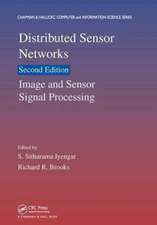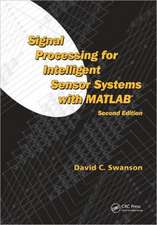Global Mobile Satellite Systems: A Systems Overview
Editat de Peter A. Swan, Carrie L. Devieux Jr.en Limba Engleză Hardback – 28 feb 2003
Major issues are examined in trade study style to provide easy access to key information. Key systems drivers such as orbit trades between LEO's, MEO's, and GEO's, frequency, protocols, customer bases, and regulatory and engineering issues are included. This book should appeal to individuals interested in the basic elements of Global Mobile Satellite Systems.
| Toate formatele și edițiile | Preț | Express |
|---|---|---|
| Paperback (1) | 610.63 lei 6-8 săpt. | |
| Springer Us – 31 oct 2012 | 610.63 lei 6-8 săpt. | |
| Hardback (1) | 617.39 lei 6-8 săpt. | |
| Springer Us – 28 feb 2003 | 617.39 lei 6-8 săpt. |
Preț: 617.39 lei
Preț vechi: 726.35 lei
-15% Nou
Puncte Express: 926
Preț estimativ în valută:
109.25€ • 128.11$ • 95.94£
109.25€ • 128.11$ • 95.94£
Carte tipărită la comandă
Livrare economică 02-16 februarie 26
Preluare comenzi: 021 569.72.76
Specificații
ISBN-13: 9781402073847
ISBN-10: 1402073844
Pagini: 170
Ilustrații: XV, 170 p.
Dimensiuni: 155 x 235 x 17 mm
Greutate: 0.47 kg
Ediția:2003
Editura: Springer Us
Colecția Springer
Locul publicării:New York, NY, United States
ISBN-10: 1402073844
Pagini: 170
Ilustrații: XV, 170 p.
Dimensiuni: 155 x 235 x 17 mm
Greutate: 0.47 kg
Ediția:2003
Editura: Springer Us
Colecția Springer
Locul publicării:New York, NY, United States
Public țintă
ResearchCuprins
1 Introduction to Global Mobile Satellite Systems.- 1.1 Introduction.- 1.2 Generations of GMSS.- 1.3 GMSS Categories.- 1.4 GMSS Infrastructure.- 1.5 Book Organization.- 1.6 The Challenge.- References.- 2 GMSS Architectural Comparisons.- 2.1 Introduction.- 2.2 Architectural Design Process.- 2.3 Gmss Architectural Steps.- 2.4 Summary.- References.- 3 Market Demand Considerations.- 3.1 Introduction.- 3.2 Historical Market Demand for Various Services and Consumer Products.- 3.3 Global Mobile Satellite Systems.- 3.4 Comments.- References.- 4 Regulatory and Spectrum Considerations.- 4.1 Satellite Frequency Allocations.- 4.2 Regulatory Considerations.- 4.3 Mobile Satellite Service Regulation.- 4.4 Summary.- Acknowledgement.- References.- 5 Orbital Trades.- 5.1 Introduction.- 5.2 Arguments For Non-Gso Orbits.- 5.3 Constellation Design.- 5.4 Comparison of Orbits.- 5.5 Trends in Orbits.- References.- 6 Propagation Considerations.- 6.1 Introduction.- 6.2 Satellite Geometry and Received Signal Components.- 6.3 Probability Distributions for Fading Models.- 6.4 Channel Dynamics.- 6.5 The Probability Distribution Based Land Mobile Satellite Channel Model.- 6.6 Summary.- References.- 7 Payload Trades, Antennas and Communications.- 7.1 Introduction.- 7.2 Basic Features of a Payload.- 7.3 Antennas.- 7.4 Link Budgets.- 7.5 Polarization and Frequency Reuse.- 7.6 Access Techniques: FDMA, TDMA, CDMA.- 7.7 Coding: Trading Bandwidth for Power.- 7.8 Space High Power Amplifiers.- 7.9 Transparent vs. Regenerative Payloads.- 7.10 Inter-Satellite Links.- 7.11 The Satellite Bus.- 7.12 Space Segments Technology Trends.- References.- 8 GMSS Summary.- 8.1 Achievements.- 8.2 Architectural Approach.- 8.3 Eventual Success.- 8.4 The Future of GMSS.- 8.5 The Customer.






















